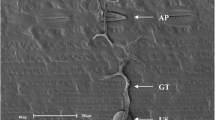Abstract
When the influence of host species, inoculum density, temperature, leaf wetness duration, and leaf position on the incidence of gentian brown leaf spot caused by Mycochaetophora gentianae, was examined, the fungus severely infected all seven Gentiana triflora cultivars, but failed to infect two cultivars of G. scabra and an interspecific hybrid cultivar. Inoculum density correlated closely with disease incidence, and a minimum of 102 conidia/mL was enough to cause infection. In an analysis of variance, temperature and leaf wetness duration had a significant effect upon disease incidence, which increased with higher temperature (15–25°C) and longer duration of leaf wetness (36–72 h). No disease developed at temperatures lower than 10°C or when leaf wetness lasted <24 h. At 48-h leaf wetness, disease incidence was 0, 28, 77, and 85% at 10, 15, 20, and 25°C, respectively. Middle and lower leaves on the plant were more susceptible than upper leaves. In microscopic observations of inoculated leaves, >50% of conidia germinated at temperatures >15°C after 24-h leaf wetness. More appressoria formed at higher temperatures (15–25°C) with extended duration of leaf wetness (24–72 h). At 48-h leaf wetness, appressorium formation was 0, 8, 26, and 73% at 10, 15, 20, and 25°C, respectively. These results suggest that temperature and leaf wetness duration were important factors for infection of gentian leaves.





Similar content being viewed by others
References
Årsvoll K (1971) Acrothecium carotae. Sporulation, spore germination, and pathogenesis. Acta Agric Scand 21:3–10
Byrne JM, Hausbeck MK, Meloche C, Jarosz AM (1998) Influence of dew period and temperature on foliar infection of greenhouse-grown tomato by Colletotrichum coccodes. Plant Dis 82:639–641
Horikoshi N, Ono M, Tairako K (2003) Screening of effective fungicides and optimum timing for the control of disease, Kappan-byo, of gentian caused by Thallosporiella gentianae (abstract in Japanese). Jpn J Phytopathol 69:292–293
Kanto T, Maekawa K, Aino M (2007) Suppression of conidial germination and appressorial formation by silicate treatment in powdery mildew of strawberry. J Gen Plant Pathol 73:1–7
Kasuyama S, Idei T (1987) Prediction for occurrences of brown leaf spot of hydrangea and gentian for cut flower (new disease) in Okayama Prefecture, Japan (abstract in Japanese). Ann Phytopathol Soc Jpn 53:377–378
Kobayashi T, Kasuyama S, Nasu H, Ono Y, Watanabe K (2009) Brown leaf spot disease of gentian, Gentiana scabra var. buergeri (Miq.) Maxim. and its causal fungus (in Japanese with English summary). Jpn J Phytopathol 75:1–8
Magarey RD, Sutton TB, Thayer CL (2005) A simple generic infection model for foliar fungal plant pathogens. Phytopathology 95:92–100
Murray TD, Ye H (1986) Papilla formation and hypersensitivity at penetration sites and resistance to Pseudocercosporella herpotrichoides in winter wheat. Phytopathology 76:737–744
Nakatani F, Takahashi S (1991) Occurrence and control of disease, Kappan-byo, of gentian caused by Thallosporiella gentianae Yokoyama et Kasuyama (in Japanese). Ann Rep Plant Prot North Jpn 42:66–68
Nekoduka S, Katsube K (2003) Infection period and optimum timing for the control of disease, Kappan-byo, of gentian (abstract in Japanese). Ann Rep Plant Prot North Jpn 54:208
Nekoduka S, Tanaka K, Harada Y, Sano T (2010) Phylogenetic affinity of Mycochaetophora gentianae, the causal fungus of brown leaf spot on gentian (Gentiana triflora), to Pseudocercosporella-like hyphomycetes in Helotiales. Mycoscience 51:123–133
Xi K, Burnett PA, Tewari JP, Chen MH, Turkington TK, Helm JH (2000) Histopathological study of barley cultivars resistant and susceptible to Rhynchosporium secalis. Phytopathology 90:94–102
Yoshiike T (1992) Foundation of cultivation. In: Yoshiike T (ed) Breeding and cultivation of gentian (in Japanese). Seibundoshinkosha, Tokyo, pp 68–72
Acknowledgments
The authors gratefully acknowledge Takashi Hikage (Hachimantai City Floricultural Research and Development Center) for sampling original gentian cultivars in Hachimantai City, Dr. Hiromitsu Furuya and Dr. Hidekazu Takahashi (Faculty of Biological Resources, Akita Prefectural University) for advice on the design of experimental and statistical methods, and Dr. Naoyuki Matsumoto (National Agricultural Research Center for Hokkaido Region) for critically reading the manuscript. This study was supported by “Research and development projects for application in promoting new policy of Agriculture Forestry and Fisheries” (No. 2040) from the Ministry of Agriculture, Forestry and Fisheries of Japan.
Author information
Authors and Affiliations
Corresponding author
Rights and permissions
About this article
Cite this article
Nekoduka, S., Tanaka, K. & Sano, T. Pathogenicity of Mycochaetophora gentianae, causal fungus of gentian brown leaf spot, as affected by host species, inoculum density, temperature, leaf wetness duration, and leaf position. J Gen Plant Pathol 76, 370–376 (2010). https://doi.org/10.1007/s10327-010-0274-x
Received:
Accepted:
Published:
Issue Date:
DOI: https://doi.org/10.1007/s10327-010-0274-x




